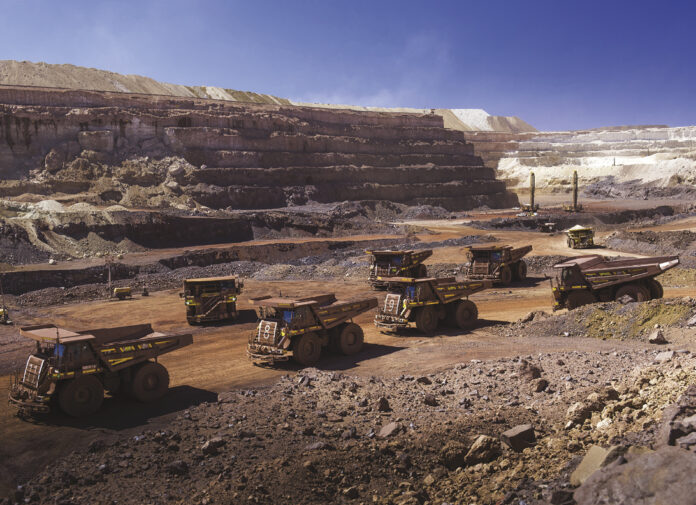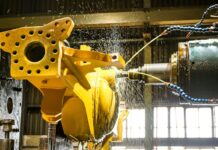Green hydrogen is hydrogen created using renewable resources, and the Northern Cape has those in abundance. The Northern Cape Green Hydrogen strategy was announced in 2021 at COP26. A Northern Cape Green Hydrogen Symposium was held in 2022 and Sasol is in the process of conducting a pre-feasibility study on hydrogen for the province. Any developments in that sphere will be linked with, and give a boost to, the Boegoebaai Harbour project.
The National Department of Mineral Resources and Energy, in collaboration with the Northern Cape Provincial Government, hosted the Northern Cape Mining and Minerals Investment Conference in March 2022 in Kimberley. The department’s stated goal is that all South Africans should derive sustainable benefit from the country’s resources. The province’s considerable mineral wealth was outlined to potential investors and plans for infrastructure development (such as industrial parks and Special Economic Zones) were highlighted.
The Kathu Industrial Park is particularly well placed to support the mining sector as it is close to the Postmasburg-Hotazel iron-ore/manganese belt (or Gamagara Mining Corridor) and is easily accessible from the N14 highway. The Namakwa SEZ in Aggeneys is being envisioned as an industrial cluster for mining and agriculture services, beneficiation and manufacturing.
Other topics covered at the conference included spending on Social Labour Plans (SLP), enterprise support and localisation of procurement, a description of the current and future investment environment for junior and emerging miners, and development funding and infrastructure to enable mining.
The biggest new mine in the country is a zinc mine at Aggeneys, the Gamsberg project of Vedanta Zinc International, which will deliver 600 000 tons of zinc when phase three is complete. The provincial government is using the mine’s location (and possible future smelter) as the basis for a new Namakwa Special Economic Zone. The SEZ forms part of a larger “multi-nodal” corridor envisaged for the province.
An old zinc mine that produced a million tons of zinc and 430 000 tons of copper before it closed in 1991 is to be revived by Australian miner Orion Minerals. A bankable feasibility study has been completed and it confirmed earlier positive findings. Another company exploring the potential of the Northern Cape as a source of high-quality base metals is SHiP Copper.
Mining assets
The Northern Cape Department of Economic Development and Tourism’s “Economic and Investment Profile” reports that the province is responsible for:
- 95% of South Africa’s diamond output
- 97.6% of alluvial diamond mining
- 13.4% of world lead exports. Aggeneys, in the Namaqualand district, is responsible for approximately 93% of South Africa’s lead production.
- 80% of the world’s manganese resource
- 25% of the manganese used in the world
- 100% of South Africa’s tiger’s eye
- Largest national production of sugilite (a semi-precious stone).
Away from the underground kimberlite pipes and fissures, river and coastal deposits of diamonds are also present in the Northern Cape. Diamonds have been recovered along the Orange, Buffels, Spoeg, Horees, Groen, Doom and Swart rivers in the province, while coastal deposits have been found from the mouth of the Orange River to Lamberts Bay.
News
Big Tree Copper has plans to list on one of South Africa’s stock exchanges. The company, which rebranded from the name Cape Copper Oxide Company, had to delay its planned 2021 listing because the licence of the ZARX exchange was suspended on liquidity concerns. The company intends to produce 2 000 tons per year of high purity copper plate from the retreatment of waste ore dumps.
Ntsimbintle Holdings, a broad-based black empowerment investment company, has spent R1.3-billion to raise its stake in Jupiter Mines to 19.9%. The Tshipi Borwa manganese mine (majority-owned by Ntsimbintle Mining, with Jupiter a 49.9% shareholder) is an open-cast mine that is not only the largest single manganese mine and exporter from South Africa but is also one of the five largest manganese ore exporters in the world.
Ntsimbintle consistently pays out good dividends to a variety of community groups and trusts. As of mid-2021, a total of R3.2-billion had been paid out.
A subsidiary of Menar is developing a new manganese mine at Hotazel. Named the East Manganese mine project, the subsidiary, Sitatunga Manganese, expects to run for three years. The life of the Kolomela mine will be extended via a R7-billion expansion project that includes the development of a new pit. Kumba Iron Ore expects the new section to produce ore in 2024.
Afrimat continues to expand its commodities portfolio with the purchase for R300-million of Coza Mining, an iron-ore mining company in the Northern Cape. The Afrimat transaction includes the share previously held by ArcelorMittal SA, which will receive iron ore from Coza in terms of a supply agreement. Coza’s three mines, Doornpan, Driehoek and Jenkins, are close to Afrimat’s exisiting Demineng Mine, which is south-west of Kuruman.
The global market for base metals (which includes zinc and nickel) is in good shape because of trends in the energy and automotive markets and the fact that the global supply of copper is expected to decline.
Sector resources
- Minerals Council South Africa: www.mineralscouncil.org.za
- National Department of Mineral Resources: www.dmr.gov.za
- Northern Cape Department of Economic Development and Tourism: www.northern-cape.gov.za/dedat









